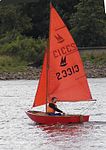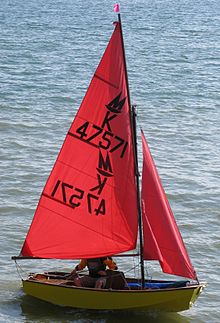- Mirror (dinghy)
-
Current Specifications 
A Mirror on Combs Reservoir in Derbyshire
Class SymbolCrew 2 LOA 3.30 m (10 ft 10 in) LWL 1.38 m (4 ft 6 in)[citation needed] Beam 1.39 m (4 ft 7 in) Draft .700 m (2 ft 3.6 in) Hull weight 45.5 kg (100 lb) Mainsail area 4.6 m2 (50 sq ft) Jib / Genoa area 1.9 m2 (20 sq ft) Spinnaker area 4.4 m2 (47 sq ft) The Mirror is a very popular sailing dinghy, with more than 70,000 built.
The Mirror was named after the Daily Mirror, a UK newspaper with a largely working class distribution. The Mirror was from the start promoted as an affordable boat, and as a design it has done a great deal to make dinghy sailing accessible to a wide audience. Although most popular in the UK, Mirrors are also sailed in other countries, notably Australia, Ireland, Sweden, Canada, the Netherlands, South Africa, New Zealand, the Philippines and the United States.
Contents
Design
The Mirror was designed by Jack Holt and TV do-it-yourself expert Barry Bucknell in 1962.[1] It employed a novel construction method where sheets of marine plywood are held together with copper stitching and fibreglass tape. This is called tack and tape or stitch and glue construction. Buoyancy is provided by four independent integral chambers rather than by bags. It was originally designed to be built with simple tools and little experience, and this meant that the design was quite simple. For example, the characteristic 'pram' front reduces the need for the more complicated curved wooden panels and joinery needed for a pointed bow, and a daggerboard is used instead of a hinged centreboard. The result is a robust, versatile and fairly light boat that can be easily maintained and repaired, and can also be got into the water very quickly from storage or transport. Although most experienced sailors would carry a paddle rather than oars, if necessary it rows well. If the transom is strengthened, an outboard motor can be used for propulsion.
The original rig was a Gunter Rig, but in 2006 the class rules were changed to allow a single mast and an alloy boom.[2] Although a Bermudan sloop rig has now been introduced for the Mirror, the original Gunter rig (with a gaff that effectively doubles the height of the mast) meant that all the spars could be packed inside the hull for easy storage or transportation. This same space saving is still available with the Bermudan rig by using an optional two-piece aluminium mast. Mirrors can be sailed without a jib by moving the mast into an optional forward step and moving the shroud attachment points forward. However, in this configuration it can be difficult to tack, so it would mainly be used to de-power the boat for beginners. Most single handers retain the mast in the standard position and handle the jib as well: because of the Mirror's small size, this is quite manageable.
Mirror class rules permit the use of a spinnaker. This may also be used by single handers as well - although flying a main, jib and spinnaker single-handed sounds complex, it is quite manageable with a bit of practice.
Mainsail controls permitted by the class are downhaul (Cunningham), outhaul and kicking strap (Vang). The Jib tack fixing may also be adjustable while sailing allowing changes in jib luff tension and tack height.
The Mirror is light and stable enough to be sailed safely by two young teenagers or two adults. It is an excellent boat for children or teenagers learning sailing for the first time.[citation needed]
Racing
Despite not being a particularly fast dinghy, the Mirror is popular for one-design racing.[3] Because of the very large number that have been made, it is fairly easy to find other Mirror sailors to race against - at least in the countries where the Mirror is popular. The large fleet of similar boats coupled with the Mirror's stability and relative complexity (for a boat of this size) make it the ideal boat to learn racing skills. It is a recommended UK Olympic pathway boat and many top sailors learned their trade in mirrors. Mirrors are raced competitively worldwide.
The Mirror World Championship is contested biennially (every two years) by the nations of Ireland, the UK, the Republic of South Africa, Canada, New Zealand, Sweden, Netherlands and Australia. Ireland has dominated the event over the past decade, winning the championship in 1999 (Marty Moloney and Revelin Minihane), 2001 (Peter Bayly and William Atkinson), 2003 (Chris Clayton and Craig Martin) and 2005 (Ross Kearney and Adam Mc Cullough) although the last two world championships have been won by British pairings. Anna Mackenzie and Holly Scott from team GBR were the first all-female team to win the title in 2007 which was contested in Durban, South Africa. Andy and Tom Smith also from Great Britain won the event in 2009 in Pwlleli, Wales.
Former world champion Ross Kearney won both the 2010 Mirror European championships at Sligo Yacht Club, and the 2011 Mirror World Championship held in Albany, Western Australia, with current crew Max Odell.
Cruising
Mirrors are suitable for cruising in coastal waters - one has even been sailed and rowed singlehanded from Ellesmere (near Liverpool) to the Black Sea.[4] Because there are so many of them around, it is fairly easy to find others to sail with. In bad weather, Mirrors remain well behaved and have inspired confidence in many young sailors. Their seaworthiness is excellent for their size.[citation needed]
Mirror No 1 may be seen at the National Maritime Museum Cornwall[5]
References
- ^ "History". UK Mirror Class association. http://www.ukmirrorsailing.com/mca/history.htm.
- ^ "Class". UK Mirror Class association. http://www.ukmirrorsailing.com/.
- ^ "Attendance at UK National Championships". http://www.yachtsandyachting.com/classes/?s=44.
- ^ The story of this journey is told in the book The Unlikely Voyage of Jack de Crow: A Mirror Odyssey from North Wales to the Black Sea, by A. J. Mackinnon (ISBN 978-1-57409-152-6)
- ^ NMMC website
External links
- International class association
- UK Mirror Class Association
- Irish Mirror class Association
- West Australian Mirror Association
- Ontario Mirror Dinghy Association
- USA Mirror Dinghy Sailing
- Dutch Mirror Class Association
- Tasmanian Mirror Class Association
- Mirror Class Race Results
- Videos of the 2009 World championships in Wales
- Video of the 2007 World championships in South Africa
ISAF sailing dinghy classes 29er • 420 • 470 • 49er • 505 • B14 • Byte • Cadet • Contender • Enterprise • Europe • Finn • Fireball • Flying Dutchman • Flying Junior • GP14 • International 14 • Laser Standard • Laser II • Laser 4.7 • Laser Radial • Laser Vago • Lightning • Mirror • Moth • Musto Performance Skiff • OK Dinghy • O'pen BIC • Optimist • RS500 • RS Feva • RS Tera • Snipe • Splash • Sunfish • Tasar • Topper • Vaurien • Zoom 8Sailing dinghy, Sharpie and Skiff classes Dinghies under 10 ft Frog • Cape Cod Frosty • El Toro • Fatty Knees • Fly • Holdfast Trainer • Manly Junior • Minto • Naples Sabot • O'pen BIC • Optimist • P Class • Pelican • Puddle Duck Racer • Sabot • Starling • Tadpole • Topper Topaz Taz • Turnabout • Zoom 8Dinghies under 15 ft 10ft Skiff • 12 foot dinghy • 125 ("One-twenty-five") • 12ft Skiff • 13ft skiff • 29er • 29erXX skiff • 3000 • 405 ("Four-oh-five") • 420 • Access Liberty • Adventuress • ASC • Astus 14.1 • Australian Sharpie • B14 • Banshee • Beetle Cat • Bermuda Fitted Dinghy • Blaze • Blue Jay • Bosun • British Moth • Butterfly • Buzz • Byte • Cadet • Cherokee • Cherub • C-Lark • Comet • Coypu • Dabchick • Daring • Dart • Enterprise • Escape • Europe • Envy • Extra • Finn • Firefly • Flying Ant • Flying Eleven • Flying Junior • Force 5 • GP14 • Graduate • Gull • Heron • Idle-along • IDRA14 • International Twelve • International 14 • Javelin (NZ) • Javelin (US) • Jet 14 • Jollyboat (NZ) • Lark • Laser Standard • Laser 2 • Laser 2000 • Laser 3000 • Laser 4.7 • Laser 5000 • Laser Funboat • Laser Pico • Laser Radial • Laser Vago • Laser Vortex • Lido 14 • Marlin • Merlin Rocket • MG14 • Miracle • Mirror • Moth • Musto Performance Skiff • National 12 • NS14 • OK Dinghy • O'pen BIC • Otter • Pacer • Pegasus • Penguin • Phantom • RS Feva • RS Tera • RS Q'Ba • RS Feva • RS Vareo • RS100 • RS200 • RS300 • RS400 • RS500 • RS600 • RS700 • RS800 • Sabre • Scorpion • Snark • Snowbird (sailboat) • Solo • Spiral • Splash • Streaker • Sunburst • Sunfish • Tinker Star Traveller • Tinker Traveller • Tasar • Topper • Topper Topaz • Topper Topaz Magno • Topper Topaz Vibe • Topper Topaz Xenon • Twinkles 10 & 12 • Vagabond • Vaurien • Wanderer • Woodpussy • Zeddie • ZephyrDinghies under 20 ft 16ft Skiff • 18 foot dinghy • 18ft Skiff • 470 • 49er • 505 • Albacore • Beaufort • Invitation • Buccaneer 18 • Comet • Contender • Corsair • Day Sailer • Fireball • Flying Dutchman • Flying Scot • French National Monotype 1924 • Hornet • Interlake • International Canoe • Jacksnipe • Javelin (UK, NL & DE) • Jersey Skiff • Jollyboat (UK) • Jolly Boat • JY15 • Laser 4000 • Laser Bahia • Laser Stratos • Lelievlet • Lightning • Mirror 16 • Mutineer 15 • O-Jolle • Osprey • Payne-Mortlock sailing canoe • Pirate • Precision 15 • RS K6 • RS Vision • RS700 • RS800 • Salcombe Yawl • Sea Bright • Sea Scout Standard Boat (BP18) • Snipe • Texas Tornado • 12m2 Sharpie • Thistle • Topper Topaz Omega • Vanguard 15 • Wayfarer • Windmill • Windy • Winkle Brig • X boat • Y flyerDinghies 20 ft or over Categories:- Dinghies
- Boats designed by Jack Holt
Wikimedia Foundation. 2010.

